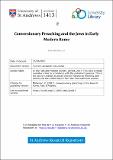Files in this item
Conversionary preaching and the Jews in early modern Rome
Item metadata
| dc.contributor.author | Michelson, Emily | |
| dc.date.accessioned | 2019-04-19T23:37:55Z | |
| dc.date.available | 2019-04-19T23:37:55Z | |
| dc.date.issued | 2017-05-23 | |
| dc.identifier | 245412304 | |
| dc.identifier | edc1cecb-bd5d-4378-820c-d911a5640c90 | |
| dc.identifier | 85021294352 | |
| dc.identifier | 000402613000003 | |
| dc.identifier.citation | Michelson , E 2017 , ' Conversionary preaching and the Jews in early modern Rome ' , Past & Present , vol. 235 , no. 1 , pp. 68-104 . https://doi.org/10.1093/pastj/gtx013 | en |
| dc.identifier.issn | 0031-2746 | |
| dc.identifier.other | ORCID: /0000-0002-7940-9954/work/74510220 | |
| dc.identifier.uri | https://hdl.handle.net/10023/17561 | |
| dc.description | The author is grateful to Villa I Tatti and the Carnegie Trust for their generous research funding. | en |
| dc.description.abstract | This article examines how a seemingly universal category, the imaginary Jew, fared in a local setting – arguably the most compelling and high-stakes local setting in Europe: early modern Rome. In Rome – the caput mundi, city of the Holy See – the premier manufacturer of Judaic symbolism confronted Europe’s oldest continuous community Jewish community. Imagined Jews and living Jews in Rome were equally robust, equally impossible to ignore, and had equal claims to antiquity. Both categories of Jews converged at the weekly conversionary sermons established in the late sixteenth century, an event that also regularly drew Christian observers from across the city as well as tourists. This article analyzes the specific manifestation of imaginary Judaism that held sway in early modern Rome, symbolized most powerfully at conversionary sermons. It argues that in early modern Rome, “imaginary Jews” was both a visual and a rhetorical category, in which living Jews acted as imaginary Jews, and which always included Christians. This definition differs from those in use elsewhere in Europe, and demonstrates that ‘imaginary’ and living Jews should not be considered opposites. This allows us in turn to understand the popularity and significance of conversionary preaching. Conversionary preaching was a uniquely potent spectacle because it addressed living Jews, imaginary Jews, and Christans alike. | |
| dc.format.extent | 967087 | |
| dc.language.iso | eng | |
| dc.relation.ispartof | Past & Present | en |
| dc.subject | Conversionary Preaching | en |
| dc.subject | Jews | en |
| dc.subject | Counter-Reformation | en |
| dc.subject | Italy | en |
| dc.subject | Early Modern Rome | en |
| dc.subject | DG Italy | en |
| dc.subject | BL Religion | en |
| dc.subject | BM Judaism | en |
| dc.subject | BR Christianity | en |
| dc.subject | History and Philosophy of Science | en |
| dc.subject | Religious studies | en |
| dc.subject | T-NDAS | en |
| dc.subject | BDC | en |
| dc.subject | R2C | en |
| dc.subject.lcc | DG | en |
| dc.subject.lcc | BL | en |
| dc.subject.lcc | BM | en |
| dc.subject.lcc | BR | en |
| dc.title | Conversionary preaching and the Jews in early modern Rome | en |
| dc.type | Journal article | en |
| dc.contributor.sponsor | Carnegie Trust | en |
| dc.contributor.institution | University of St Andrews. School of History | en |
| dc.contributor.institution | University of St Andrews. St Andrews Institute of Medieval Studies | en |
| dc.identifier.doi | 10.1093/pastj/gtx013 | |
| dc.description.status | Peer reviewed | en |
| dc.date.embargoedUntil | 2019-04-20 | |
| dc.identifier.grantnumber | 31877 | en |
This item appears in the following Collection(s)
Items in the St Andrews Research Repository are protected by copyright, with all rights reserved, unless otherwise indicated.

